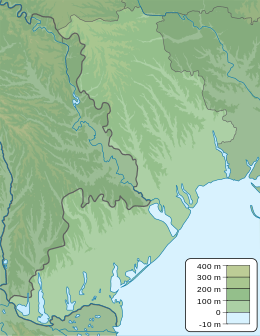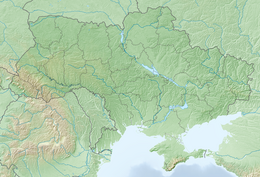
Back جزيرة الثعبان Arabic جزيرة التعبان ARZ Zmeynıy adası Azerbaijani ایلان آداسی (اوکراین) AZB Йыланлы (утрау) Bashkir Nusa Lelipi (Segara Cemeng) BAN Змяіны востраў Byelorussian Зьмяіны (востраў) BE-X-OLD Змийски остров (Украйна) Bulgarian সর্প দ্বীপ (ইউক্রেন) Bengali/Bangla
This article includes a list of general references, but it lacks sufficient corresponding inline citations. (October 2012) |
Native name: острів Зміїний | |
|---|---|
 2008 photo of the island | |
 | |
| Geography | |
| Location | Black Sea |
| Coordinates | 45°15′N 30°12′E / 45.250°N 30.200°E |
| Area | 0.17 km2 (0.066 sq mi) |
| Length | 662 m (2172 ft) |
| Width | 440 m (1440 ft) |
| Highest elevation | 41 m (135 ft) |
| Highest point | N/An |
| Administration | |
| Oblast | |
| Raion | Izmail Raion |
| Hromada | Vylkove |
| Largest settlement | Bile |
| Demographics | |
| Population | 0 |
| Pop. density | 600/km2 (1600/sq mi) |
45°15′18″N 30°12′15″E / 45.25500°N 30.20417°E Snake Island, also known as Serpent Island, White Island, Island of Achilles or Zmiinyi Island (Ukrainian: острів Змії́ний, romanized: ostriv Zmiinyi; Romanian: Insula Șerpilor), is a Ukrainian island located in the Black Sea, near the Danube Delta, with an important role in delimiting Ukrainian territorial waters.
The island has been known since classical antiquity, and during that era hosted a Greek temple to Achilles.[1] Today, it is administered as part of Izmail Raion of Ukraine's Odesa Oblast.
The island is populated, reported to have under 30 people in 2012. A village, Bile, was founded in February 2007 with the purpose of consolidating the status of the island as an inhabited place. This happened during the period in which the island was part of a border dispute between Romania and Ukraine from 2004 to 2009, during which Romania contested the technical definition of the island and borders around it. The territorial limits of the continental shelf around Snake Island were delineated by the International Court of Justice in 2009,[2] providing Romania with almost 80% of the disputed maritime territory.[3]
In the 2022 Russian invasion of Ukraine, two Russian navy warships attacked and captured Snake Island.[4] It was subsequently bombarded heavily by Ukraine[5] and recaptured within a few months, following a Russian withdrawal.[6]
- ^ Rusyaeva, Anna (1 January 2003). "The Temple of Achilles on the Island of Leuke in the Black Sea". Ancient Civilizations from Scythia to Siberia. 9 (1–2): 1–16. doi:10.1163/157005703322114810. ISSN 0929-077X.
- ^ "International Court of Justice: Maritime Delimitation in the Black Sea (Romania v. Ukraine)". Archived from the original on 24 September 2008. Retrieved 4 February 2009.
- ^ "Insula Șerpilor: Decizie favorabilă României | DW | 03.02.2009". Deutsche Welle.
- ^ Lamothe, Dan (26 February 2022). "Ukrainian border guards may have survived reported last stand on Snake Island". The Washington Post. Archived from the original on 27 February 2022. Retrieved 27 February 2022.
- ^ "Ukraine war: Snake Island and battle for control in Black Sea". BBC News. 11 May 2022. Retrieved 27 May 2022.
- ^ Koshiw, Isobel (30 June 2022). "Ukraine says it has pushed Russian forces from Snake Island". The Guardian.


